10 Best Carbon Offsets for Small & Medium Businesses (Complete 2024 List)
Impactful Ninja is reader-supported. When you buy through links on our site, we may earn an affiliate commission.
Learn more
Learn more
.
Hey fellow impactful ninja ? You may have noticed that Impactful Ninja is all about providing helpful information to make a positive impact on the world and society. And that we love to link back to where we found all the information for each of our posts. Most of these links are informational-based for you to check out their primary sources with one click. But some of these links are so-called "affiliate links" to products that we recommend. First and foremost, because we believe that they add value to you. For example, when we wrote a post about the environmental impact of long showers, we came across an EPA recommendation to use WaterSense showerheads. So we linked to where you can find them. Or, for many of our posts, we also link to our favorite books on that topic so that you can get a much more holistic overview than one single blog post could provide. And when there is an affiliate program for these products, we sign up for it. For example, as Amazon Associates, we earn from qualifying purchases. First, and most importantly, we still only recommend products that we believe add value for you. When you buy something through one of our affiliate links, we may earn a small commission - but at no additional costs to you. And when you buy something through a link that is not an affiliate link, we won’t receive any commission but we’ll still be happy to have helped you. When we find products that we believe add value to you and the seller has an affiliate program, we sign up for it. When you buy something through one of our affiliate links, we may earn a small commission (at no extra costs to you). And at this point in time, all money is reinvested in sharing the most helpful content with you. This includes all operating costs for running this site and the content creation itself. You may have noticed by the way Impactful Ninja is operated that money is not the driving factor behind it. It is a passion project of mine and I love to share helpful information with you to make a positive impact on the world and society. However, it's a project in that I invest a lot of time and also quite some money. Eventually, my dream is to one day turn this passion project into my full-time job and provide even more helpful information. But that's still a long time to go. Stay impactful,Affiliate Disclosure
Why do we add these product links?
What do these affiliate links mean for you?
What do these affiliate links mean for us?
What does this mean for me personally?
![]()
Small businesses have been referred to as the backbone of our global economy. It is estimated that small businesses make up 90% of global companies and account for 50% of jobs worldwide. So, we had to ask: What are the best carbon offsets for small businesses?
The best carbon offsets for small businesses are Terrapass, Carbonfund, and Climeworks. In addition, Clear offers solutions to offset specific business activities (such as flights) while Ecologi provides a framework for a climate-positive workforce.
Keep reading to learn more about the best carbon offsets for small businesses, how these carbon offset projects work, what their respective offsetting costs are, and what your best way would be to offset your carbon emissions. At the end of the article, we’ll also share with you what the biggest carbon offsetting limitations are and why reducing your carbon footprint is more effective than offsetting it.
Here’s What All the Best Carbon Offsets for Small Businesses Have in Common
Carbon offsets are reductions in carbon emissions that are used to compensate for carbon emissions occurring elsewhere. They are measured in tons of CO2 equivalents and are bought and sold through international brokers, online retailers, and trading platforms on what is known as the global carbon offset market.
“Carbon Offset: a way for a company or person to reduce the level of carbon dioxide for which they are responsible by paying money to a company that works to reduce the total amount produced in the world, for example by planting trees”
Oxford Dictionary
When you purchase carbon offsets, it’s important that they actually make a difference in total carbon emissions. To achieve that, the following are key criteria:
- Carbon offset projects have to be effective (different projects have different effectiveness rates)
- Carbon offset projects have to be additional
- Carbon offset projects have to be permanent
- The claims from carbon offset projects have to be verifiable
(For a full overview, check out our guide on how to choose carbon offset projects that actually make a difference.)
These Are the Best Carbon Offsets for Small Businesses in 2024
Below are our favorite carbon offsets for small businesses (you can click on their link to directly jump to their section in this article):
| Carbon Offsets for Small Businesses | Quick Facts |
| Terrapass | About: Carbon offset purchases support farm power, landfill gas capture, clean energy from wind power, and abandoned coal mine methane capture carbon offset projects. Costs: $16.99 per 1,000kg of CO2 |
| Carbonfund | About: Carbon offset purchases support third-party validated and verified energy efficiency, forestry, and renewable energy carbon offset projects globally. Costs: $390-$1,560 per year for small businesses dependent on the number of employees |
| Climeworks | About: Carbon offset purchases support the practice of direct CO2 removal, where specialized machines remove CO2 directly from the air and store it in rock formations underground. Costs: Evaluated after a personal contact |
| Clear | About: Carbon offset purchases support reforestation, efficient cookstoves, renewable energy, methane capture, and landfill gas capture carbon offset projects. Costs: $25 per 1,000kg of CO2 |
| Ecologi | About: Carbon offset purchases support forest restoration, renewable energy, clean cookstoves, and clean drinking water offset projects. A certain number of trees are also planted with every offset purchase. Costs: $6 per 1,000kg of CO2 |
| myclimate | About: Carbon offset purchases support energy efficiency, forestry, waste management, and renewable energy carbon offset projects. Costs: Determined after completing their carbon emissions calculator |
| Paying.Green | About: Carbon offset purchases support carbon emissions reduction and carbon offset projects including biogas/biomass energy, solar/wind/hydro-power, reforestation, waste handling disposal, and nitrogen oxide abatement. Costs: From $50 (for up to 4 employees) to $950 (for up to 250 employees) per month |
| Cool Effect | About: Carbon offset purchases support avoided nature loss (forestry, tree planting, grasslands), methane capture, and clean cookstoves carbon offset projects. Costs: $14.62 per 1,000kg of CO2 |
| Offset Alliance | About: Carbon offset purchases support reforestation, clean energy, short grass prairie protection, and sawdust to energy projects. Costs: $12.41 per 1,000kg of CO2 |
| Reforest’Action | About: Carbon offset purchases support reforestation projects on 5 continents Costs: Evaluated after a personal contact |
Terrapass: Carbon Offsets for Individuals and Businesses
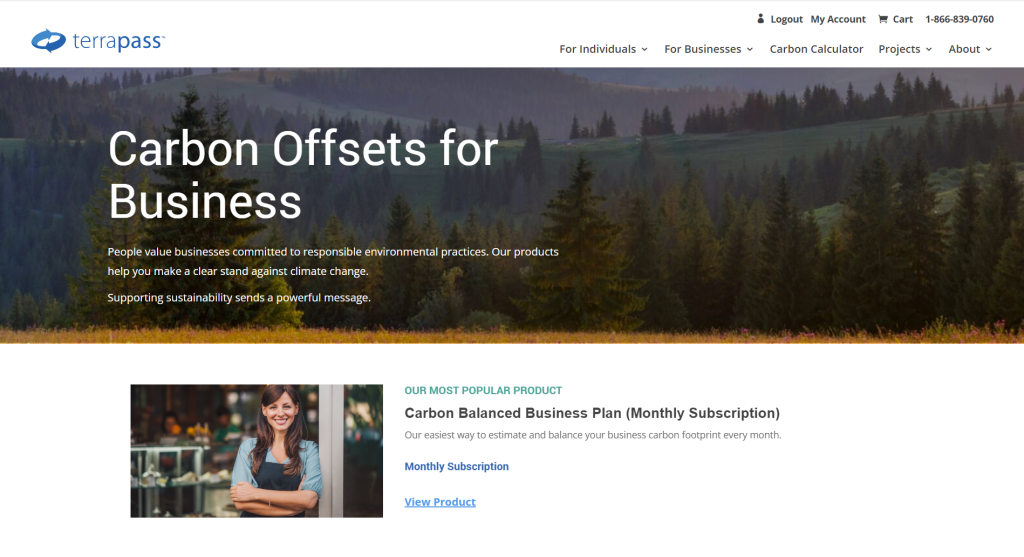
Terrapass is an organization that has been providing carbon offsets to individuals and businesses since 2004. In 2020, Terrapass customers offset roughly the same amount of carbon as planting 7 million trees. Their mission is to fight climate change by reducing as many carbon emissions as possible via the use of education, online tools, carbon offsets, and renewable energy.
“Restore the balance”
Terrapass
Carbon offset overview: Terrapass has many options for businesses looking to offset their carbon footprint. They offer a carbon balanced business plan (monthly subscription), business offsets, flight offsets, and a business gift of Terrapass. Purchases help fund carbon offset projects including farm power, landfill gas capture, clean energy from wind power and abandoned coal mine methane capture.
Carbon offset effectiveness: Terrapass uses the Verified Carbon Standard, Gold Standard, American Carbon Registry and the Climate Action Reserve to help ensure transparency and quality in the creation, quantification, and verification of offset projects.
Carbon offset costs: Terrapass offers 5 business carbon offset options which work out to approximately $16.99 per 1,000kg of CO2 offset.
- Carbon Balanced Business plan: $8.50 per employee per month. It assumes that your business generates up to 500kg (0.5 tonnes) of CO2 per employee per month.
- Business Carbon Offsets: $16.99 per 500kg (one-time) or $16.49 per 500kg (monthly subscription) of CO2 offset
- Flight Carbon Offsets: $8 per 454kg (1,000lbs) of CO2 offset.
- Business Gift of Terrapass: $16.99 per 1,000kg of CO2 offset. It includes a minimum 1,000kg of CO2 offsets, a holiday certificate, and a holiday e-card
How to get your carbon offsets: Visit the Terrapass website to purchase your carbon balanced business plan, business offsets, flight offsets, or a business gift of Terrapass.
Carbonfund: Go Carbon Neutral
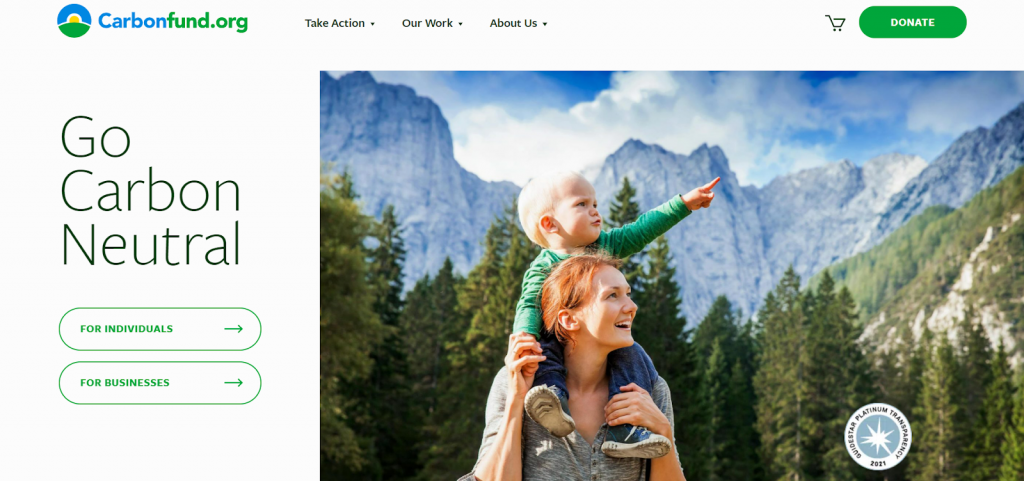
Carbonfund is a nonprofit organization founded in 2003 by current President Eric Carlson and is based in New York, United States of America. Their mission is to make it easy for any individual, business, or organization to reduce & offset their climate impact and hasten the transition to a clean energy future.
“Reduce what you can, offset what you can’t”
Carbonfund
Carbon offset overview: Carbonfund offers an innovative and flexible way to help your business calculate, reduce and offset your carbon footprint, named the Carbonfree® Partner Program. Their Carbonfree® Small Business Program (20 or fewer employees) is an annual renewal Program where your donation supports carbon reduction projects around the world. Purchases support energy efficiency, forestry, and renewable energy carbon offset projects globally. To date, they have supported 240 projects in 28 countries.
Carbon offset effectiveness: Carbonfund projects are third-party verified and adhere to the Verified Carbon Standard, Gold Standard, American Carbon Registry, and Climate Action Reserve.
Carbon offset costs: The Carbonfree® Small Business Program costs $390, $780, or $1,560 per year for businesses containing 1-5, 6-10, or 11-20 employees, respectively.
How to get your carbon offsets: Visit their Carbonfree® Partner Program webpage to learn more about the small business options and to offset your business’s carbon footprint.
Climeworks: The Leader in Direct CO2 Removal
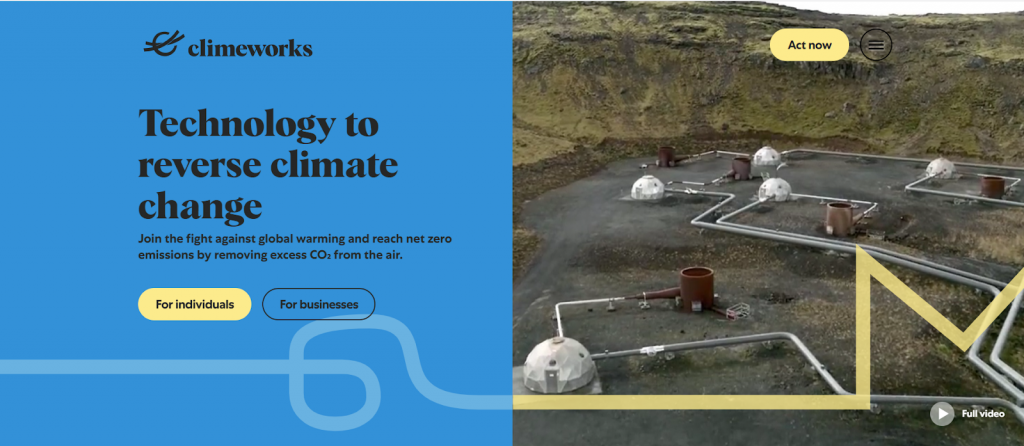
Climeworks, a DAC company in Zurich, Switzerland, is the leader in the CO2 removal game. It was founded in 2009 by engineering university students Jan and Christoph, who were shocked at the melting glaciers in the Swiss Alps. Climeworks’ mission is to inspire one billion people to remove CO2 from the air and reverse climate change.
“Let’s reverse climate change”
Climeworks
Project overview: The Climeworks specialized machines take CO2 from the air, mix it with water, and pump it deep underground. Through the process of natural mineralization, the captured CO2 is turned to stone. Since their inception in 2017, Climeworks has built 15 DAC machines and switched on the world’s first large-scale plant back in 2021. For every 100 tons of CO2 captured from the air, 90 tons are permanently removed, and only up to 10 tons are re-emitted by the DAC machines.
Carbon offset effectiveness: Climeworks offsets are permanent, measurable, natural, and efficient.
Carbon offset costs: The business side of Climeworks is a B2B operation where costs may be evaluated after personal contact.
How to get your carbon offsets: To learn how Climeworks B2B solutions could help your business with its climate goals, contact their sales team.
Clear: Join the Climate Change Mission

Clear was founded in 2005, when climate change first hit society’s radar. They provide individuals and businesses the opportunity to offset activities such as staying in hotels, commuting, public transport, maritime freight, and even skydiving and balloon flights. Their mission is to use technology and innovation to empower individuals and smaller companies to easily take environmental action now.
“Will this carbon offset really cover the emissions I can’t avoid creating?” Clear is dedicated to living up to that promise.”
Clear
Carbon offset overview: Clear offers a variety of business carbon offset options, including direct carbon offsets, hotel stays, business vehicles, offices and factories, business internet, raw materials and manufacturing, waste disposal and recycling, business commuting, business fuel, air freight, sea freight cargo, wastewater and sewage, mains water supply, and business flights. They offer the option to make your purchase carbon-neutral, 50% carbon negative, 100% carbon negative, or 200% carbon negative. Purchases support projects involving reforestation, efficient cookstoves, renewable energy, methane capture, and landfill gas capture.
Carbon offset effectiveness: Clear carbon offsets are the first in the world to be independently certified against the Quality Assurance Standard (QAS), a comprehensive independent audit system for companies wanting to become carbon neutral through carbon reduction.
Carbon offset costs: The cost to offset emissions from your business is approximately $25 per 1,000kg of CO2. They also offer the option to make your purchase carbon negative at 50%, 100%, or 200% which increases the overall cost accordingly.
How to get your carbon offsets: You can use the Clear carbon offset calculator to calculate and offset your emissions from various business sectors.
Ecologi: Where Carbon Reduction Partners With Tree Planting
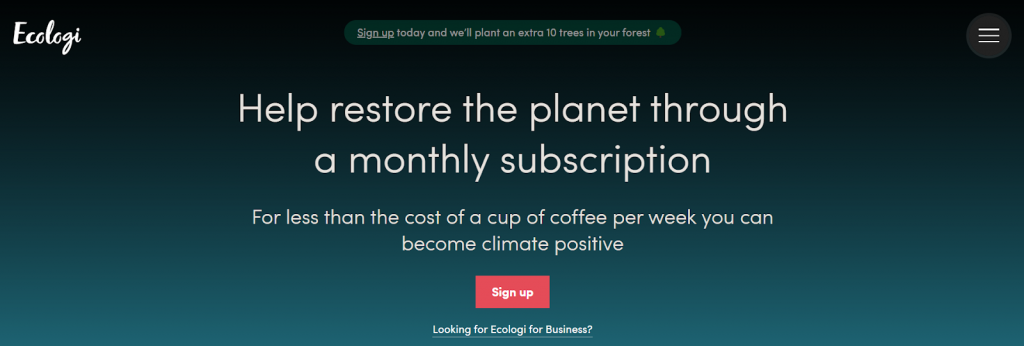
Ecologi was founded in 2019 in Bristol, United Kingdom when CEO and cofounder Elliot Coad was driving to work and thought, “How much climate action could I fund with the money for a coffee?” Through Ecologi, you can offset your or your businesses carbon footprint through verified carbon offsets. And a certain number of trees are also planted so they can sequester carbon once they mature. To date they have helped 11,878 businesses prioritize climate action.
“Ecologi is your partner all the way to Net Zero.”
Ecologi
Project overview: Ecologi’s framework for businesses is the Climate Positive Workforce. This means that when you partner your business with Ecologi, you’ll be offsetting your employees’ entire carbon footprint and their business travel while planting trees for every employee. Purchases support projects including, but not limited to, forest restoration, renewable energy, clean cookstoves, and clean drinking water. When you purchase carbon offsets through Ecologi, trees are planted as a bonus, because it takes years for trees to mature and sequester carbon in large quantities.
Carbon offset effectiveness: Ecologi uses the Verified Carbon Standard and the Gold Standard to help ensure transparency and quality in the creation, quantification, and verification of offset projects. They also have tree planting partners who are able to responsibly plant millions of trees a month on their behalf. These partners include Eden Reforestation Projects, One Tree Planted, and Trees for the Future, all of which are included in our list of the Best Charities for Planting Trees.
Carbon offset costs: Ecologi offers 3 business plans which work out to approximately $6 per 1,000kg of CO2 offset.
- Employees: This plan factors in minor business travel and costs $11.60 per employee per month. It offsets 1,700kg of CO2 and plants 12 trees every month.
- Intermittent Jet Setter Employees: This plan factors in medium business travel and costs $21 per employee per month. It offsets 3,500kg of CO2 and plants 24 trees every month.
- Frequent Long-Hauler Employees: This plan factors in major business travel and costs $42 per employee per month. It offsets 7,000kg of CO2 and plants 48 trees every month.
How to get your carbon offsets: Visit Ecologi’s business carbon offsetting webpage to learn more about the Climate Positive Workforce and find out how Ecologi can help your business.
myclimate: Shaping the Future
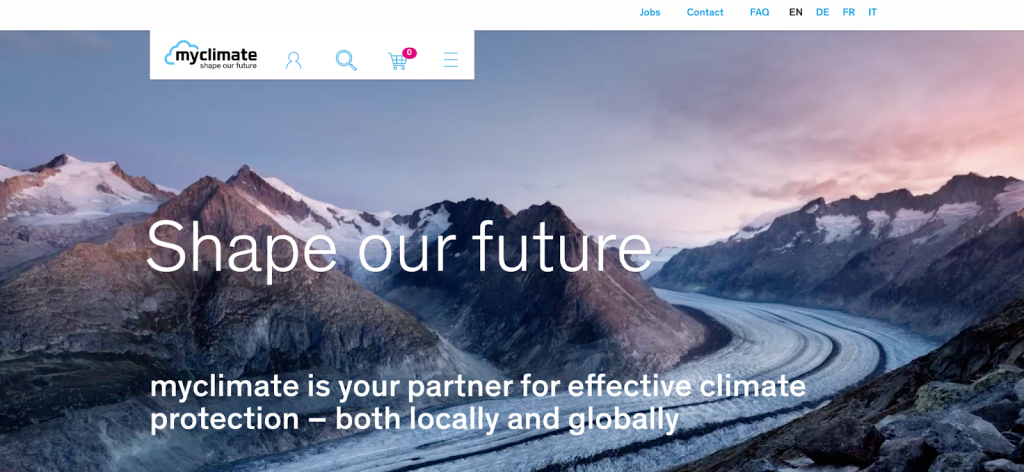
myclimate is an international, Swiss-based initiative that is one of the world’s leaders in voluntary carbon compensation measures. They work with small, medium, and large companies, public administrations, non-profit organizations, and private individuals to provide high-quality projects with quantifiable climate protection. Their mission is to be a partner for global and local climate protection and to shape the future of the world through advisory services and educational programs.
“myclimate is your partner for effective climate protection – locally and globally”
myclimate
Carbon offset overview: myclimate offers the option to offset your company’s annual emissions. Purchases fund offset projects including energy efficiency, forestry, waste management, renewable energy. Some examples include efficient cookstoves in the Himalayas, forest management in Switzerland, and hydropower in Vietnam.
Carbon offset effectiveness: myclimate uses the Gold Standard, VCS, or Plan Vivo to help ensure transparency and quality in the creation, quantification, and verification of offset projects. Their projects also adhere to the UN’s Sustainable Development Goals.
Carbon offset costs: Costs are determined after completing myclimate’s carbon emissions calculator.
How to get your carbon offsets: Visit their website to calculate and offset your businesses’ carbon emissions.
Paying.Green: Smarter Net Zero
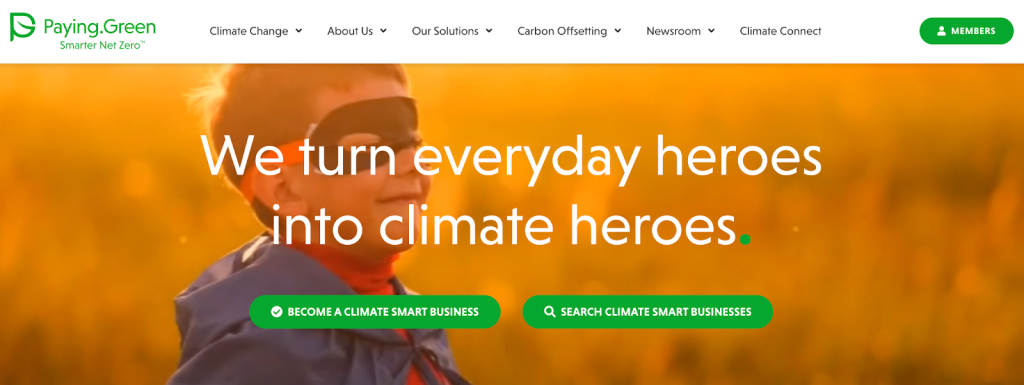
Paying.Green is a global climate action organization that raises funds in order to purchase and retire selected carbon offset credits at wholesale prices. They have constructed wholesale pricing, tax-exempt, not-for-profit, transparent governance structures that disrupt the traditional carbon offsetting industry. Their goal is to become the world’s largest people-powered carbon emissions offsetting community.
“Our atmosphere has no borders. Neither do we.”
Paying.Green
Project overview: Paying.Green offers 2 Smarter Net Zero® climate solutions that are designed to help businesses meet their climate goals. The money that they raise from those subscriptions goes towards investing in offset projects including biogas/biomass energy, solar/wind/hydro-power, reforestation, waste handling disposal, and nitrogen oxide abatement projects.
Carbon offset effectiveness: Paying.Green only acquires verified carbon credits under the United Nations Framework Convention on Climate Change. They do not speculate or trade in carbon credits and retire those credits at the same time they are acquired, which ensures no double counting. Additionality (financial and environmental), permanence, validation, and verification are of utmost importance to them.
Carbon offset costs: Paying.Green offers two subscriptions for businesses looking to achieve their climate goals.
- Carbon 360™: Price is determined after initial contact. This subscription offers businesses the option to decarbonize and transition to Carbon Neutrality or Net Zero status.
- Climate Smart Payments: Price is determined after initial contact. In this subscription, you partner your business with Paying.Green, which engages your customers to buy and retire carbon credits.
How to get your carbon offsets: Visit the Paying.Green website to view and customize your Carbon 360™ or Climate Smart Payments subscription. You can also contact them with any questions.
Cool Effect: Giving Like the Planet Depends on It
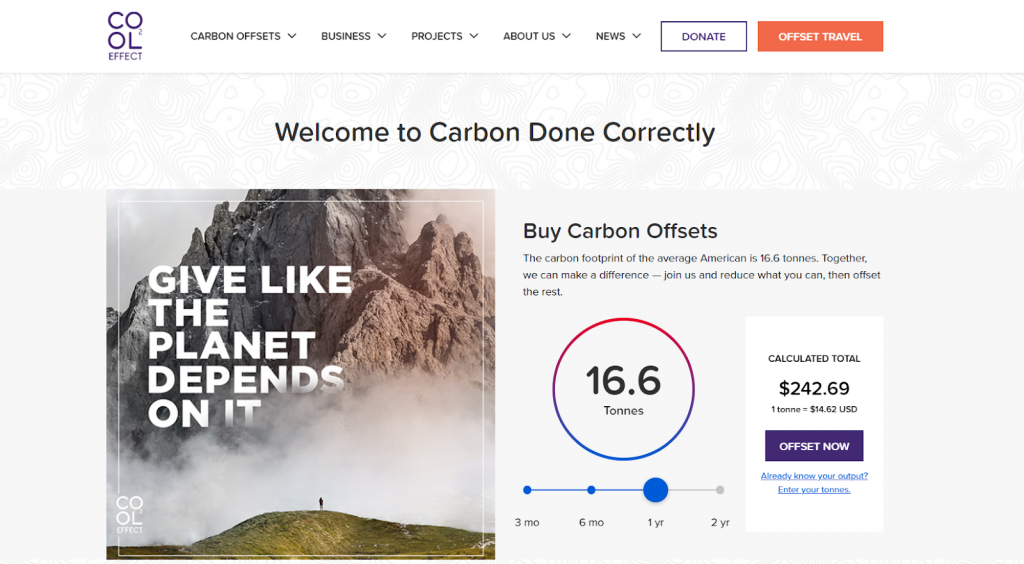
Cool Effect began in 1998 with a small, clean-burning cookstoves project in Honduras and has since grown to represent a platform with 15+ global projects and a community of more than 500,000. Their mission is to give people the power and confidence to band together and reduce the carbon pollution that causes climate change.
“Carbon done correctly”
Cool Effect
Carbon offset overview: Cool Effect has a Business Carbon Offset Calculator that offsets your businesses’ carbon footprint in terms of power consumption. It takes into account the number of employees, and you can choose between the following 3 methods of calculation: monthly utility bill, monthly utility usage, or office square footage. Purchasing carbon offsets funds projects involving avoided nature loss (forestry, tree planting, grasslands), methane capture, and clean cookstoves. These projects are located in the United States (Montana, Oregon, Tennessee), India, China, Myanmar, Indonesia, Honduras, Kenya, and Uganda.
Carbon offset effectiveness: Cool Effect projects are 100% additional, rigorously verified, and adhere to the UN’s Sustainable Development Goals.
Carbon offset costs: It costs approximately $14.62 per 1,000 kg of CO2 offset.
How to get your carbon offsets: Visit Cool Effect’s business carbon offset calculator to enter your information and offset your business’ power consumption.
Offset Alliance: High Impact Climate Action
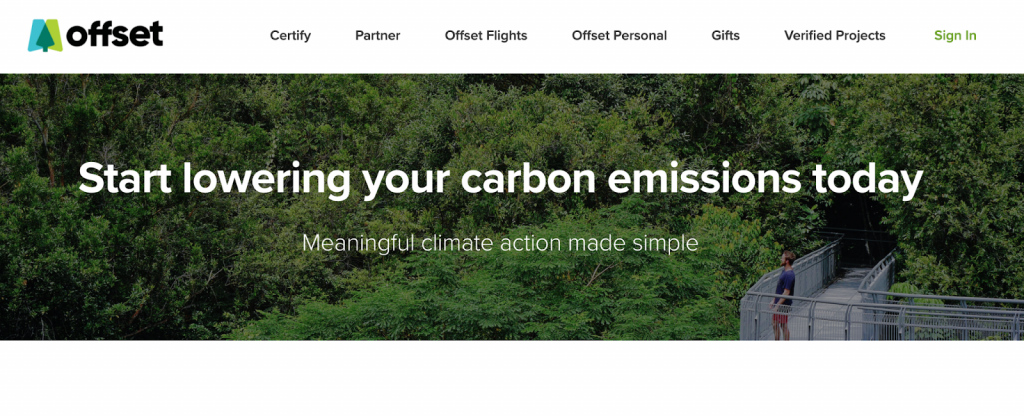
Offset Alliance is a designated Woman Owned Small Business founded in 2019 with the aim of addressing climate change and having a positive impact on local and global communities. Their mission is to make measurable and meaningful climate action simple.
“Meaningful climate action made simple”
Offset Alliance
Carbon offset overview: Offset Alliance offers carbon offset subscriptions that support reforestation in Zimbabwe and Alaska, clean energy in Costa Rica, short grass prairie protection in Colorado, and sawdust to energy operations in Chile.
Carbon offset effectiveness: Offset Alliance uses the Verified Carbon Standard, Gold Standard, American Carbon Registry and the Climate Action Reserve to help ensure transparency and quality in the creation, quantification, and verification of offset projects. They are also third-party verified and adhere to the UN’s Sustainable Development Goals.
Carbon offset costs: Offset Alliance offers 3 monthly subscriptions which offset either 8,700, 17,400, or 35,900 kg of CO2 per year at a cost of $12.41 per 1,000kg of CO2 offset.
How to get your carbon offsets: Visit their webpage to choose a monthly carbon offset subscription.
Reforest’Action: Tackling Deforestation on a Global Level
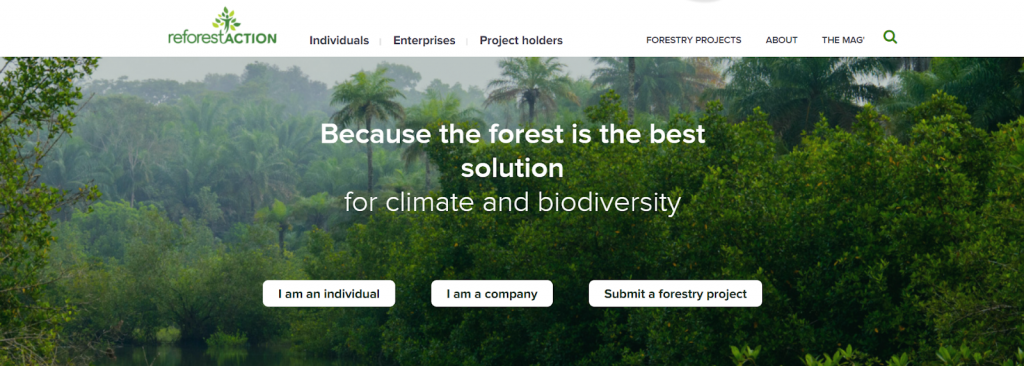
Reforest’Action is a French crowdplanting company founded in 2010 by Stéphane Hallaire. To date, they have financed more than 20 million trees in 40 different countries. Their mission is to preserve, restore, and create forests globally so that we may continue to reap the environmental, social, and economic benefits for many years to come.
“Because the forest is the best solution for climate and biodiversity”
Reforest’Action
Project overview: Purchasing offsets from Reforest’Action supports the restoration and development of tomorrow’s carbon sinks. They currently have active reforestation projects in Europe, North America, South America, Africa, Asia, and Oceania. Reforest’Action offers 4 business solutions for companies looking to make an impact. You can finance forests, contribute to global carbon neutrality, create a customized agroforestry project, or plant an urban forest.
Carbon offset costs: This is a business-to-business (B2B) operation where costs are determined after contacting the Reforest’Action Team.
How to get your carbon offsets: For all of their business offerings, contact a Reforest’Action team member directly.
How to Choose Carbon Offset Projects Actually Make a Difference
The following information is a summary for you based on our full guide: “How to Buy Carbon Offsets That Actually Make a Difference”
Purchase carbon offset projects with high effectiveness rates. The offset programs in order of most to least effective are:
- Direct CO2 removal: Machines remove CO2 directly from the air. Effective at reducing emissions in the short and long-term because they are additional and permanent.
- Renewable energy: Investing in projects that build and maintain renewable energy sites globally. There is no additionality because renewables are becoming a greater share of our energy mix, with or without the help of offsets.
- Energy efficiency improvements: The creation of products or systems that use less energy than conventional systems to perform the same task. However, if products are replaced too quickly, the amount of CO2 required to produce the new product would exceed the amount of CO2 saved with the new product.
- Carbon sequestration: The long-term storage of carbon via forestry practices. Not an effective way to reduce emissions in the long-term because there is no guaranteed permanence.
If – and only if – they are both additional and permanent, carbon offsets can help reduce your overall GHG emissions to balance off your personal carbon footprint to fight climate change – at least in the short term. But they can be much more effective if they meet certain key criteria and project standards.
Here are key criteria to look for in a carbon offset program:
- A clearly defined protocol that determines which types of projects are eligible and how emission reductions will be measured
- Independent third-party verification of compliance with the protocol
- Registration of offsets in an offset registry, which tracks each credit with a unique serial number to ensure it is only used once
- Transparency in project implementation and reporting
If used correctly, carbon offsets can provide environmental, economic, and social benefits that go beyond reducing carbon emissions. They have the potential to instigate meaningful environmental change and begin to reverse some of the effects of climate change.
Carbon offset project standards assure transparency and quality in the creation, quantification, and verification of offset projects. This way you can ensure that the project is actually reducing CO2 emissions. The following are recognized carbon offset standards:
- Verified Carbon Standard (VCS): Considered the world’s leading voluntary GHG program, with 1700+ projects having removed 630+ million tons of CO2 from the atmosphere. Examples of projects include hydropower in Turkey, forest conservation in Peru, and landfill gas capture in China.
- Gold Standard: A certification that seeks to maximize every dollar of climate and development funding. It has issued 134 million carbon credits from 1700+ projects based in more than 80 different countries. Examples of projects include solar power in India, efficient cooking and heating in China, and wind power in Indonesia.
- Climate Action Reserve (CAR): The premier carbon offset registry for the North American carbon market having issued over 150 million offset credits since its inception in 2001. Examples of projects include landfill gas capture in South Carolina and forest management in California.
- American Carbon Registry (ACR): The first private voluntary GHG registry in the world. Examples of projects include ozone-depleting substances in Arkansas and methane capture from mines in Kentucky.
Choosing carbon offset projects from any of the above project standard registries helps ensure that your project is verified and that it actually reduces CO2 emissions.
What Are the Biggest Carbon Offsetting Limitations
In fact, there are 9 main carbon offsetting limitations that can make the current voluntary carbon market controversial and lead to confusion, inconsistencies, and a general distrust of the system. Have a look at the quick summary table below.
| Carbon Offsetting Limitation | Quick Facts |
| #1: You don’t reduce your own carbon footprint | When you purchase a carbon offset, you are paying someone else to cut their emissions so you don’t have to cut your own emissions. |
| #2: Carbon offsets do not work at the core issue of reducing CO2 emissions | Global warming is still occurring at an accelerated rate because offsetting CO2 emissions does not cut CO2 emissions at the source, it only mitigates emissions. |
| #3: Carbon offsetting only reduces CO2 if the projects are additional and permanent | If carbon offset projects are not additional and permanent, they can make climate change worse because they are not offsetting any carbon. |
| #4: “Poorer” countries are paid to offset carbon while the “rich” countries continue to emit | The richest of the world emit the majority of the world’s carbon. Offsets are just licenses to pollute with the benefit of aiding those in developing countries. |
| #5: Different projects have different effectiveness rates | The varying levels of effectiveness of carbon offset programs make it difficult to choose one that actually reduces emissions. The most effective offset programs are renewable energy programs, followed by energy efficiency improvements, carbon sequestration, and aviation offset programs. |
| #6: CO2 offsets are only realized at the end of project durations | If a carbon offset program is not carried out until the end, then we cannot reap the program’s benefits. For example, planting trees is a common offset program that is only effective if those planted trees are protected during their life span for the carbon benefits to be realized. |
| #7: There are not enough offsets for all CO2 emissions | We emit far more CO2 than we can offset because of carbon sink (e.g., atmosphere, forests, soil, ocean) limitations. |
| #8: Not all offset projects get realized | Of the credits for 1 billion tons of CO2 listed on registries, only about 300-400 million tons of CO2 offsets actually get realized. |
| #9: Carbon offsetting projects are often used as greenwashing | Investing in non-verified credits, not prioritizing in-house emissions reductions, and double-counting carbon credits are methods of greenwashing. Also, companies may advertise a specific program, but it may be just for public attention instead of actually reducing emissions. |
Why Reducing Your Carbon Footprint Is More Effective Than Offsetting It
The main argument against carbon offsets is that they don’t really reduce overall emissions. Instead of substituting offsetting carbon emissions, we should instead cut the emissions directly at the source. Basically, if we stop emissions from getting into the atmosphere in the first place, we won’t have to worry about offsetting. But have we done this? Have we cut emissions directly at the source? The data says no.
The COVID-19 pandemic triggered the largest decrease in energy-related carbon emissions since World War II, a decrease of 2 billion tons. However, emissions rebounded quickly at the end of 2020, with levels in December ending 60 million tons higher than those in December 2019. This indicates that the earth is still warming at an accelerated rate, and not enough is being done to implement clean energy practices.
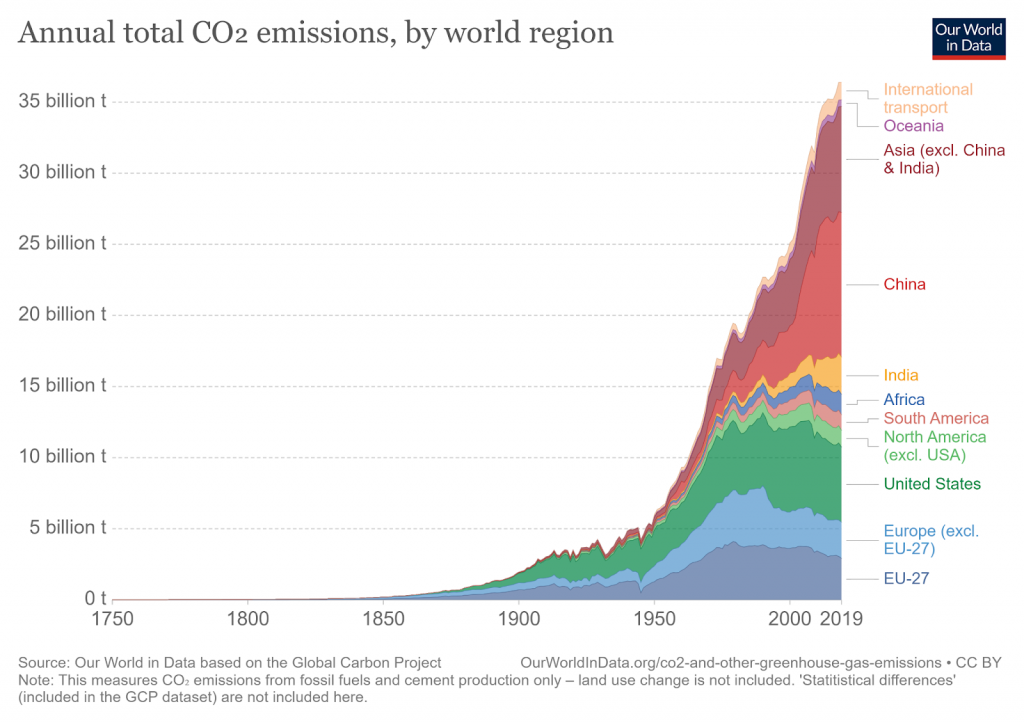
When you buy a carbon offset, you are paying someone else to cut their emissions so you don’t have to cut your own emissions. This is why offsetting alone will not be enough to reduce global carbon emissions.
Carbon offsets are a good place to start if you want to get into the carbon-emission reduction game, but in order to be effective in the long term, we must not rely on them solely. Cutting emissions from the source and then offsetting the remainder is the best way to reduce our carbon footprint and provide the highest environmental benefits. If we fail to cut emissions first, we will fill up our carbon sinks and render them unusable. Preventing carbon emissions rather than reacting once they are already emitted is the best way to reduce overall emissions.
Carbon offsets reduce GHG emissions from coal, oil, and natural gas. Reducing your consumption of these, in turn, reduces your carbon footprint, which has huge impacts on environmental, economic, and public health. A reduced carbon footprint due to lower GHG emissions can mitigate the effects of climate change, improve public health, boost the economy, and maintain plant and animal diversity.
- Climate change: Reducing your carbon footprint plays a role in mitigating the side effects of global climate change. The more we reduce the amount of GHG emissions, the more we slow the rate of temperature rise, sea-level rise, ice melting, and ocean acidification.
- Public health: Reducing GHG emissions lessens the likelihood and severity of extreme weather events, improves air and water quality, maintains biodiversity, and supports a healthy food supply.
- Economics: Reducing GHG boosts the economy, especially when it becomes economically rewarding to innovate solutions that help protect our planet, fight climate change, and are based on clean energy.
- Plant and animal diversity: Protecting biodiversity protects human health because many plants and animals are used in modern medicines
Carbon offsets have the potential to instigate meaningful environmental change, but to make the greatest impact we must understand both their benefits AND drawbacks.
Final Thoughts
Terrapass, Carbonfund, and Climeworks have the best carbon offset options for small businesses looking to reduce their carbon footprint. They either have specific programs for small businesses or have a variety of options for small businesses to offset different aspects of their companies. They are third-party verified, permanent, additional, and use the leading carbon offset standards.
Overall, carbon offsets can help reduce your overall carbon emissions to balance off the carbon footprint of your to fight climate change – at least in the short term. But in the long term, direct methods of carbon footprint reduction are much more effective. Reducing your business’ carbon footprint first before relying on carbon offsets can make more of a difference in the fight against climate change.
Stay impactful,

Sources
- Brimco: Business Statistics You Should Know in 2022
- U.S. Environmental Protection Agency: Offsets and RECs -What’s the Difference?
- Britannica: Carbon Offset
- David Suzuki Foundation: Are carbon offsets the answer to climate-altering flights?
- Impactful Ninja: How to Buy Carbon Offsets That Actually Make a Difference (Complete 2022 Guide)
- Terrapass: Homepage
- Terrapass: About Terrapass
- Terrapass: Carbon Balanced Business Plan
- Terrapass: Business Carbon Offsets
- Terrapass: Flight Carbon Offset
- Terrapass: Business Gift of Terrapass
- Carbonfund: Homepage
- Carbonfund: About Carbonfund.org
- Carbonfund: Carbonfree Partner Programs for Businesses
- Carbonfund: Become a Small Business Partner
- Carbonfund: Energy Efficiency
- Carbonfund: Forestry
- Carbonfund: Renewable Energy
- Carbonfund: Carbonfund.org Foundation Project Maps
- Carbonfund: Contact the Carbonfund.org Foundation
- Climeworks: Homepage
- Climeworks: Direct air capture – a technology to remove CO₂
- Climeworks: Reverse climate change by removing CO2 from the air
- Climeworks: Contact our sales team
- Climeworks: Direct Air Capture as a Net-Zero Solution
- Clear: Homepage
- Clear: About Us
- Clear: Business Flights
- Clear: Carbon offset projects at Clear
- Quality Assurance Standard: Homepage
- Clear: Carbon Offsets for Businesses
- Ecologi: Homepage
- Ecologi: Carbon Offsetting and Measuring Footprints for Businesses
- Ecologi: Climate Positive Workforce
- Ecologi: Reforestation and Carbon Offsetting Projects
- Verra: Verified Carbon Standard
- Gold Standard: Gold Standard Impact
- Eden Reforestation Projects: Homepage
- One Tree Planted: Homepage
- Trees for the Future: Homepage
- Impactful Ninja: 9 Best Charities for Reforestation
- Ecologi: Build Your Business Plan
- myclimate: Homepage
- myclimate: About myclimate
- myclimate: Offset your company’s annual emissions
- Paying.Green: Homepage
- Paying.Green: About Us
- Paying.Green: Carbon Offsetting
- United Nations Framework Convention on Climate Change: Homepage
- Paying.Green: Carbon 360™
- Paying.Green: Climate Smart Payments
- Paying.Green: Contact Us
- Cool Effect: Homepage
- Cool Effect: Our History
- Cool Effect: Our Mission is to Reduce Climate Change
- Cool Effect: Business Carbon Offset Calculator
- Cool Effect: Scientifically Verified Carbon Projects and Pricing
- Cool Effect: Our Approach
- Offset Alliance: Homepage
- Offset Alliance: About Offset Alliance
- Offset Alliance: Carbon Offsets
- Offset Alliance: Carbon Offsets Monthly Subscription
- Reforest’Action: Homepage
- Reforest’Action: A Unique Model of Crowdplanting
- Reforest’Action: Our Mission
- Reforest’Action: Our Reforestation Projects
- Reforest’Action: Our Business Solutions
- Reforest’Action: Finance Forests
- Reforest’Action: Contribution for the climate
- Reforest’Action: Create your customised agroforestry project
- Reforest’Action: Plant an urban forest
- Reforest’Action: Contact
- Natural Resources Defense Council: Carbon Offsets 101
- Terrapass: Project Standards
- Verra: Verified Carbon Standard
- Verra: Tepekisla Dam & Hydropower Plant Project
- Verra: The Jaguar Amazon Redd+ Project
- Verra: Sanya Landfill Gas Power Generation Project
- Gold Standard: Gold Standard Impact
- Climate Action Reserve: About Us
- Climate Action Reserve: Registry
- Climate Action Reserve: Bluesource – Berkeley County Landfill Gas Project
- Climate Action Reserve: Buckeye Forest Project
- American Carbon Registry: Our Mission
- American Carbon Registry: Registry
- American Carbon Registry: EOS Climate ODS destruction
- American Carbon Registry: Baker Mine AMM
- Impactful Ninja: What Are the Biggest Carbon Offsetting Limitations? (All 9 Explained)
- GreenPeace: The biggest problem with carbon offsetting is that it doesn’t really work
- International Energy Agency: After steep drop in early 2020, global carbon dioxide emissions have rebounded strongly
- Our World in Data: Annual total CO2 emissions
- Impactful Ninja: What Is the Carbon Footprint of Coal Energy? A Life-Cycle Assessment
- Impactful Ninja: What Is the Carbon Footprint of Oil Energy? A Life-Cycle Assessment
- Impactful Ninja: What Is the Carbon Footprint of Natural Gas? A Life-Cycle Assessment
- Impactful Ninja: 4 Main Reasons Why Reducing Your Carbon Footprint Is Important
- National Wildlife Federation: Climate Change
- National Institute of Environmental Health Sciences: Health Impacts of Climate
- Carbon Tax Center: What’s a Carbon Tax?
- World Health Organization: Biodiversity and Health
- Impactful Ninja: Can You Really Offset Your Carbon Footprint? Here Are the Facts




